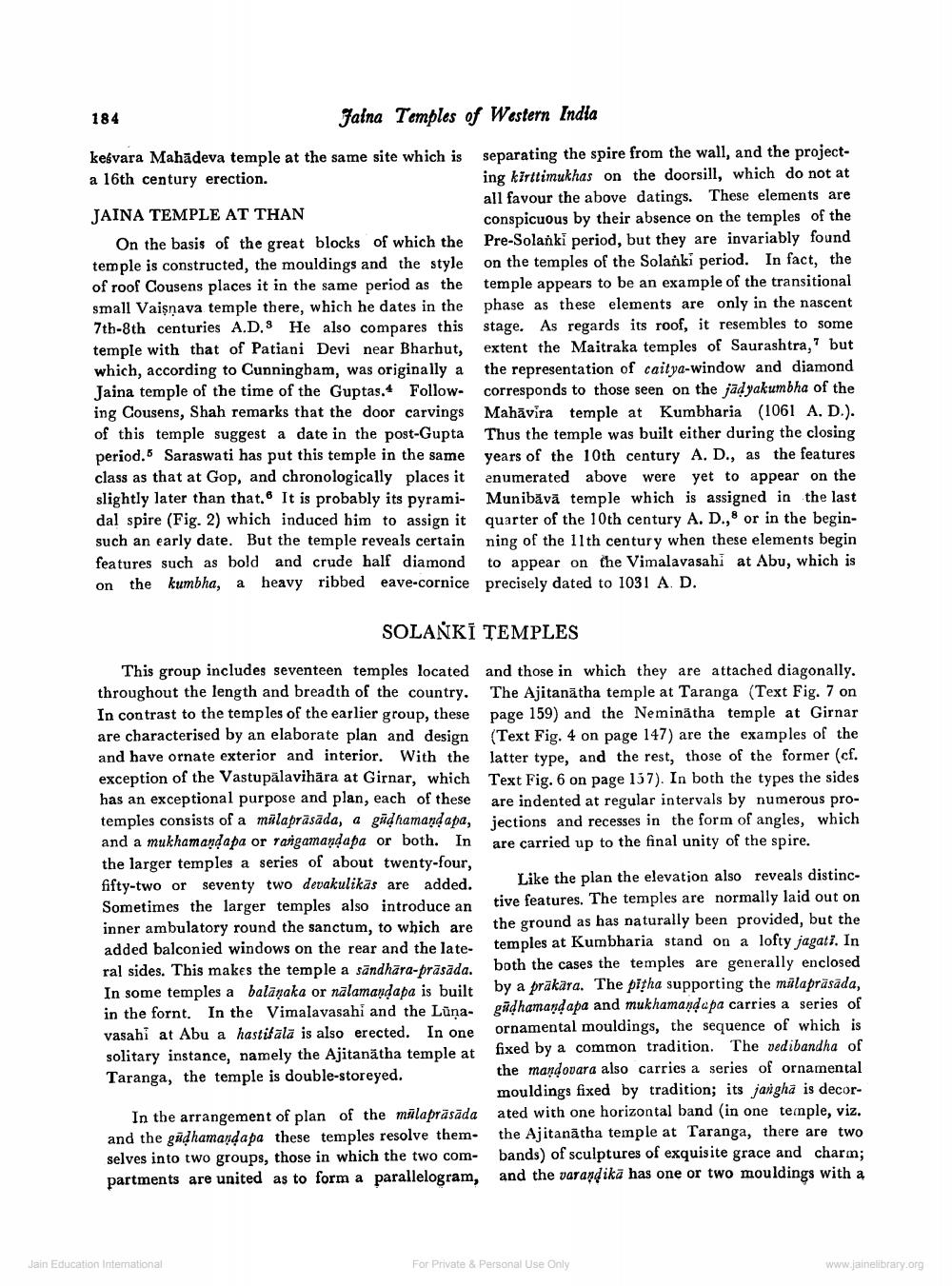________________
184
Jalna Temples of Western India
keśvara Mahadeva temple at the same site which is separating the spire from the wall, and the projecta 16th century erection.
ing kirttimukhas on the doorsill, which do not at
all favour the above datings. These elements are JAINA TEMPLE AT THAN
conspicuous by their absence on the temples of the On the basis of the great blocks of which the Pre-Solanki period, but they are invariably found temple is constructed, the mouldings and the style on the temples of the Solanki period. In fact, the of roof Cousens places it in the same period as the temple appears to be an example of the transitional small Vaisnava temple there, which he dates in the phase as these elements are only in the nascent 7th-8th centuries A.D. He also compares this stage. As regards its roof, it resembles to some temple with that of Patiani Devi near Bharhut, extent the Maitraka temples of Saurashtra,' but which, according to Cunningham, was originally a the representation of caitya-window and diamond Jaina temple of the time of the Guptas. Follow- corresponds to those seen on the jadyakumbha of the ing Cousens, Shah remarks that the door carvings Mahāvira temple at Kumbharia (1061 A. D.). of this temple suggest a date in the post-Gupta Thus the temple was built either during the closing period.5 Saraswati has put this temple in the same years of the 10th century A. D., as the features class as that at Gop, and chronologically places it enumerated above were yet to appear on the slightly later than that. It is probably its pyrami- Munibāvā temple which is assigned in the last dal spire (Fig. 2) which induced him to assign it quarter of the 10th century A. D.,8 or in the beginsuch an early date. But the temple reveals certain ning of the 11th century when these elements begin features such as bold and crude half diamond to appear on the Vimalavasahi at Abu, which is on the kumbha, a heavy ribbed eave-cornice precisely dated to 1031 AD.
SOLANKI TEMPLES
This group includes seventeen temples located and those in which they are attached diagonally. throughout the length and breadth of the country. The Ajitanātha temple at Taranga (Text Fig. 7 on In contrast to the temples of the earlier group, these page 159) and the Neminātha temple at Girnar are characterised by an elaborate plan and design (Text Fig. 4 on page 147) are the examples of the and have ornate exterior and interior. With the latter type, and the rest, those of the former (cf. exception of the Vastupalavihära at Girnar, which Text Fig. 6 on page 157). In both the types the sides has an exceptional purpose and plan, each of these are indented at regular intervals by numerous protemples consists of a mülaprāsāda, a gädhamandapa, jections and recesses in the form of angles, which and a mukhamanda pa or rangamandapa or both. In are carried up to the final unity of the spire. the larger temples a series of about twenty-four, fifty-two or seventy two devakulikās are added. Like the plan the elevation also reveals distincSometimes the larger temples also introduce an tive features. The temples are normally laid out on inner ambulatory round the sanctum, to which are the ground as has naturally been provided, but the added balconied windows on the rear and the late temples at Kumbharia stand on a lofty jagati. In ral sides. This makes the temple a sāndhāra-prāsāda.
both the cases the temples are generally enclosed In some temples a balanaka or nalamandapa is built by a prakara. The pitha supporting the malaprasada, in the fornt. In the Vimalavasahi and the Lūna. gadhamand apa and mukhamande pa carries a series of vasahi at Abu a hastitala is also erected. In one ornamental mouldings, the sequence of which is solitary instance, namely the Ajitanätha temple at fixed by a common tradition. The vedibandha of Taranga, the temple is double-storeyed.
the mandovara also carries a series of ornamental
mouldings fixed by tradition; its jangha is decorIn the arrangement of plan of the mālaprāsāda ated with one horizontal band (in one temple, viz. and the gūdhamandapa these temples resolve them the Ajitanātha temple at Taranga, there are two selves into two groups, those in which the two com- bands) of sculptures of exquisite grace and charm; partments are united as to form a parallelogram, and the varandika has one or two mouldings with a
Jain Education Interational
For Private & Personal use only
www.jainelibrary.org




